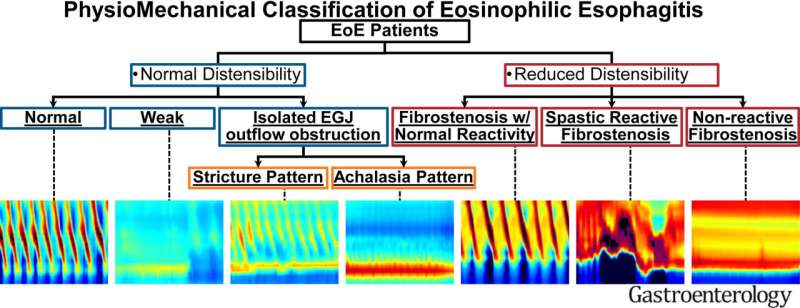This article has been reviewed according to Science X's editorial process and policies. Editors have highlighted the following attributes while ensuring the content's credibility:
fact-checked
peer-reviewed publication
trusted source
proofread
Using physiology to predict treatment response in eosinophilic esophagitis

Northwestern Medicine scientists have identified and characterized clinical outcomes and biomechanical patterns in eosinophilic esophagitis, according to a study published in the journal Gastroenterology. These findings will help define the severity of a patient's condition and predict how they will respond to treatment.
Eosinophilic esophagitis (EoE), an allergic condition of the esophagus usually triggered by a food or environmental allergen, causes inflammation, difficulty swallowing and tissue damage along the esophagus. EoE was first identified in the early 1990s, and research into the disease has been sparse.
"We were originally very interested in looking at the mechanical properties of the wall of the esophagus in eosinophilic esophagitis because we felt that it was an often-neglected component of the disease," said John Pandolfino, MD, '94 '96 '01 GME, the Hans Popper Professor and chief of Gastroenterology and Hepatology in the Department of Medicine and senior author of the study. "Over the last five years, we've developed a new approach with a technology called Flip Panometry, where we can now see not just how stiff the esophageal wall is, but also assess how the esophagus reacts to that distension."
Using the new approach that he and his colleagues developed at Northwestern, Pandolfino and collaborators measured the distensibility of each patient's esophagus by inserting a probe into the esophagus, inflating it, and then recording the reaction.
Investigators were able to define and describe several physiomechanical characteristics in more than 200 patients with EoE, including the level of stiffness in the esophagus, as well as the esophageal motility response and presence of strictures, according to the study.
After characterizing the symptom profile and physiomechanical patterns of the patients, investigators then analyzed their responses to medication designed to decrease the amount of acid produced in the stomach, a standard therapy for EoE.
The esophageal characteristics of each patient predicted how well they responded to the drug, investigators found. Patients who were characterized as having either spastic-reactive fibrostenosis or nonreactive fibrostenosis—two types of chronic inflammation in the esophagus leading to tissue damage—were significantly less likely to respond to the treatment, according to the study.
The findings of the study establish a spectrum of disease severity for EoE and may help guide patients' treatment plans, Pandolfino said.
"These findings are going to be very helpful in allowing us to better define how at-risk patients are for food impactions and complications of EoE," Pandolfino said. "This is also going to allow the physician to have a higher level of confidence as to the response rate of the patient to specific therapies so they can make predictions or at least decisions to personalize the approach for people with EoE."
Dustin Carlson, MD, '15 MS, '12 GME, assistant professor of Medicine in the Division of Gastroenterology and Hepatology and first author of the study, said he hopes to further assess the findings in a larger population in the future. "Our next steps are to validate these findings in larger, prospectively evaluated patient cohorts, as well as to further explore additional underlying pathophysiologic mechanisms related to our proposed EoE phenotypes," Carlson said.
More information: Dustin A. Carlson et al, A Physiomechanical Model of Esophageal Function in Eosinophilic Esophagitis, Gastroenterology (2023). DOI: 10.1053/j.gastro.2023.05.031





















